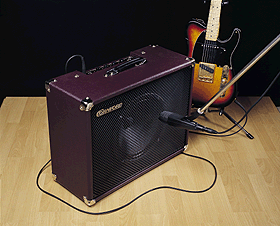I have been recording music for many years and sometimes you have to "break out of the box" to get a unique sound. A little known and somewhat unusual technique for recording guitar is a technique I call "re-amping". Recording guitar is all about frequency and harmonics, the more variates of the two, the better the tone. One way to thicken up you tone is re-amping.
This is how you do it...
When you are setting up your guitar rig for recording, take the output from your guitar into a "Y" splitter box, I like to use a Morley ABY box in the "Y" mode. This splits your guitar signal into 2 identical signal paths. Take one signal path an connect it as you normally would to your amp. Record with a microphone placed between the center and outside edge of the cone of your amp's speaker. Assign this output to one track in your recording system.
Then take the second signal path from the "Y" splitter box and connect it directly to an input on your console, adjusting the gain on the console to get a full clean signal. Assign this output to a different track in your recording system. Now, play your guitar part and record both tracks simultaneously.
What you will end up with is one track that is your normal guitar tone and one totally clean unaffected guitar signal strait off your guitar. Now since you recorded these at the same time they are both in sync with each other. Now here comes the re- amping part, assign the clean track to an available output on your recording interface and plug that output into an amp modeler like a POD.
I really like using a modeling unit as I can scroll through all the various different amp models to find the right one quickly and it splits the signal again into a stereo mix. Now, take the left and right outputs from the POD and connect them to two additional inputs on your console and assign them to two tracks to record. Now play your previous recording while recording the two new tracks from the POD.
After you have recorded the two new tracks, mute the clean track and bring up the original and the two new tracks from the POD and adjust your mix to taste. I prefer to pan the original track in the center and the two POD tracks left and right. What's great about this is you always have that clean guitar track that you can run through anything and add back to the mix creating more tracks if you want. The possibilities are pretty much endless. Give it a try and tell me what you think...
About us:
At Music Studio Pro we are musicians, recording engineers, music producers, and music production engineers.We discuss the latest in music recording equipment and techniques as well as share many of the most well kept production secrets of the industry. We also do reviews on the latest recording gear and software. We discuss guitar tones, pedals amps and how to get the sound you have always been looking for. We review the latest synths and keybords, software plugins and all the techniques used to get the hottest sounds in the industry. We also discuss live sound and the latest live sound gear and techniques. We talk about the latest consoles, line arrays processing gear and well guarded live sound secrets that the pros in the sound industry like to keep well under wraps.


